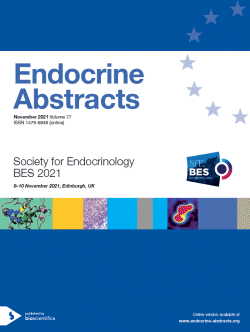
Society for Endocrinology BES 2021
Edinburgh,
United Kingdom
08 Nov 2021 - 10 Nov 2021

Oral Communications
Endocrine Cancer and Late Effects
ea0077oc2.1 | Endocrine Cancer and Late Effects | SFEBES2021
Outcomes of surgery and treatment with selective RET TK inhibitor Selpercatinib in children with MEN2 and advanced MTC.
Kurzawinski Tom , Hubbard Jonathan , Abdel Aziz Tarek , Butler Colin , Brain Caroline , Beale Tim , Gaze Mark , Ross Emma , Stoneham Sarah , Hulse Tony , Simpson Kate , Proctor Ian , Cattaneo Elene , Gevers Evelien , Marshall Lynley , Shankar Ananth
ea0077oc2.2 | Endocrine Cancer and Late Effects | SFEBES2021
An emerging role for proteostasis modulators targeting NIS activity to enhance radioiodide therapy in thyroid cancer
Read Martin , Brookes Katie , Thornton Caitlin , Nieto Hannah , Zha Ling , Fletcher Alice , Boelaert Kristien , Smith Vicki , McCabe Christopher
ea0077oc2.3 | Endocrine Cancer and Late Effects | SFEBES2021
A novel in vivo platform for studying tumour vascularization and endocrine responses
Lopes Tatiana , Prague Julia , Salem Victoria , Owen Bryn
ea0077oc2.4 | Endocrine Cancer and Late Effects | SFEBES2021
PBF phosphorylation regulates cell motility of thyroid and breast cancer cells
Kocbiyik Merve , Alshahrani Mohammed , Poole Vikki L , Jeyanathan Sakaorna , Thornton Caitlin , Zha Ling , Brookes Katie , Nieto Hannah , Read Martin L , McCabe Chris J , Smith Vicki E
ea0077oc2.5 | Endocrine Cancer and Late Effects | SFEBES2021
A novel MiR-346-Directed DNA damage mechanism is regulated by its interaction with long non-coding RNA, NORAD, in prostate cancer
Fletcher Claire , Orafidiya Folake , Deng Lin , Yuan Wei , Lorentzen Marc , Cyran Oliwia , Varela-Carver Anabel , Constantin Theodora , Dobbs Felix , Figueiredo Ines , Gurel Bora , Parkes Eileen , Bogdan Denisa , Pereira Ronnie , Zhao Shuang (George) , Neeb Antje , Issa Fadi , Hester Joanna , Kudo Hiromi , Liu Yang , Philippou Yiannis , Bristow Robert , Knudsen Karen , Bryant Richard , Feng Felix , Reed Simon , Mills Ian , de Bono Johann , Bevan Charlotte
ea0077oc2.6 | Endocrine Cancer and Late Effects | SFEBES2021
Transcriptomic analysis of succinate dehydrogenase subunit deleted cells to identify molecular mechanisms underlying the increased metastatic potential of SDHB-deficient tumours
Salsbury Grace , Hall Charlotte , Lim Eugenie , Read Jordan , Akker Scott , Chapple Paul



